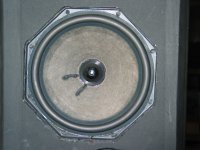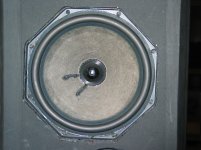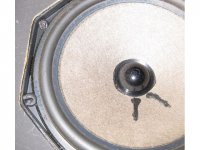IIRC the woofer is a Philips 8" AD70xx -- can you pull the bad woof and get a number? I can't recall whether they are 4 or 8 ohm (i suspect the latter -- 2 per box in parallel)
If it is what i think it is they aren't actually all that uncommon since being available to diyers they were used by a lot of small manufacturers.
dave
If it is what i think it is they aren't actually all that uncommon since being available to diyers they were used by a lot of small manufacturers.
dave
Photo of DCM Time Window Driver
An externally hosted image should be here but it was not working when we last tested it.
Im currently restoring a pair that the previous owner got rid of due to a buzzing woofer. It turned out to be a dust cap vibrating. If the voice coil isnt rubbing, then this might be the problem. The Philips woofers use a plastic dust cap that if unsecured anywhere around the perimeter, will buzz and sound like the driver is faulty. Check it by carefully putting some pressure on the cap with a Q-tip or similar soft item and see if it solves the problem.
Hope you get lucky...
amt
Hope you get lucky...
amt
Dust Cap Issue
Thanks AMT. The dust cap doesn't appear to be the problem. The dust cap adhesive seems to be solid. I don't feel the voice coil rubbing. Of course there are only certain frequencies that set up the resonance. I did notice the number SR14218 on the woofer surrounds.
Thanks AMT. The dust cap doesn't appear to be the problem. The dust cap adhesive seems to be solid. I don't feel the voice coil rubbing. Of course there are only certain frequencies that set up the resonance. I did notice the number SR14218 on the woofer surrounds.
Attachments
That number is the part number of the surround itself, not the driver.
I have experienced problems with the litz wire on some drivers vibrating against the cone causing noise - probably worth checking this.
It also seems odd that the driver is glued in place. Were there no screws holding it?
I have experienced problems with the litz wire on some drivers vibrating against the cone causing noise - probably worth checking this.
It also seems odd that the driver is glued in place. Were there no screws holding it?
I believe the driver diameter is 6 1/2 inches. The frame is octagon. I'working on a way to get the driver out. I'm going to try heating it with an infared heat lamp to soften the adhesive they used. Thanks for replying.
Greg
If there's any chance that the woofer is not very defective, it will be after you're done radiating it. Make sure the "glue" is not silicone based, for two reasons. One, you'll never get it hot enough to soften it until the cone and surround are on fire. Two, silicone is easy to separate with a moderate, persistent force. Whatever it is, use the widest "pry bar" you can get under the basket to minimize the chance of bending it. Work each of the corners individually until you make it all the way around. When it comes free, don't let the driver drop out of the cabinet on it's own or you may rip the terminals off the driver with the lead wires if they aren't very long. All this might get you a repairable driver after it's removed.
Yes they are glued in. They are also an extreme PITA to remove. The best technique seems to be to heat the area and dig them out. I havent had to do so but if I did, I would use a modified high watt soldering gun with a utility knife blade attached to heat and cut out the adhesive.
BTW, both my dust caps appeared to be well affixed to the cone but after testing, I discovered that it take just a couple millimeters of unsecured cap to make quite a racket at certain frequencies. I applied Locite 410 around it and they can play loudly with no buzz. You can see the edge of the caps are thin and sharp and over time (and movement) separate. There are gaps on this one, which is the "good" one I didnt re-glue.
amt
BTW, both my dust caps appeared to be well affixed to the cone but after testing, I discovered that it take just a couple millimeters of unsecured cap to make quite a racket at certain frequencies. I applied Locite 410 around it and they can play loudly with no buzz. You can see the edge of the caps are thin and sharp and over time (and movement) separate. There are gaps on this one, which is the "good" one I didnt re-glue.
amt
Attachments
Yes they are glued in. They are also an extreme PITA to remove. The best technique seems to be to heat the area and dig them out. I havent had to do so but if I did, I would use a modified high watt soldering gun with a utility knife blade attached to heat and cut out the adhesive.
BTW, both my dust caps appeared to be well affixed to the cone but after testing, I discovered that it take just a couple millimeters of unsecured cap to make quite a racket at certain frequencies. I applied Locite 410 around it and they can play loudly with no buzz. You can see the edge of the caps are thin and sharp and over time (and movement) separate. There are gaps on this one, which is the "good" one I didnt re-glue.
amt
I'd probably find myself poking around the edges of those dust caps with a utility or exacto blade to fine out whether there were any areas I could lift. If there are any unglued areas at all they will make noise at one point or another.
Last edited:
Since the caps are hard plastic, its really difficult to locate the exact spot were they are unattached. This is why placing slight pressure on them while they play identified them as the source of the buzz. I simple put a bead of 410 around the whole cap.
The speaker adhesive is more tar-like and does soften with heat but getting enough onto the frame without damaging the surround is the trick.
Sadly, the TW1 doesnt have removable top and bottom plates like the TW1A does. Having internal access to the speaker makes driver removal (and xo work) far easier and was definitely a good redesign.
amt
The speaker adhesive is more tar-like and does soften with heat but getting enough onto the frame without damaging the surround is the trick.
Sadly, the TW1 doesnt have removable top and bottom plates like the TW1A does. Having internal access to the speaker makes driver removal (and xo work) far easier and was definitely a good redesign.
amt
use the widest "pry bar" you can get
The ones glass installers use is good for this. Also a heavy duty utlity knife can be used to cut any of the glue on the sides of the baskets. Be very careful, a slip can slice the cone, or worse part of your anatomy.
Patience & persistance is called for.
dave
- Status
- This old topic is closed. If you want to reopen this topic, contact a moderator using the "Report Post" button.


